The kami Inari’s head shrine, Fushimi Inari-Taisha, is in Fushimi-Ku, Kyoto, Japan. The shrine is located at the base of Inari Mountain, which is 764 feet above sea level and has routes leading up the mountain to several smaller shrines that cover a hiking distance of 2.5 miles and take around 2 hours to trek up.
Continue reading to learn more about the Fushimi Inari-Taisha torii gates, why you should explore this shrine, its sightseeing features, and other nearby tourist attractions.
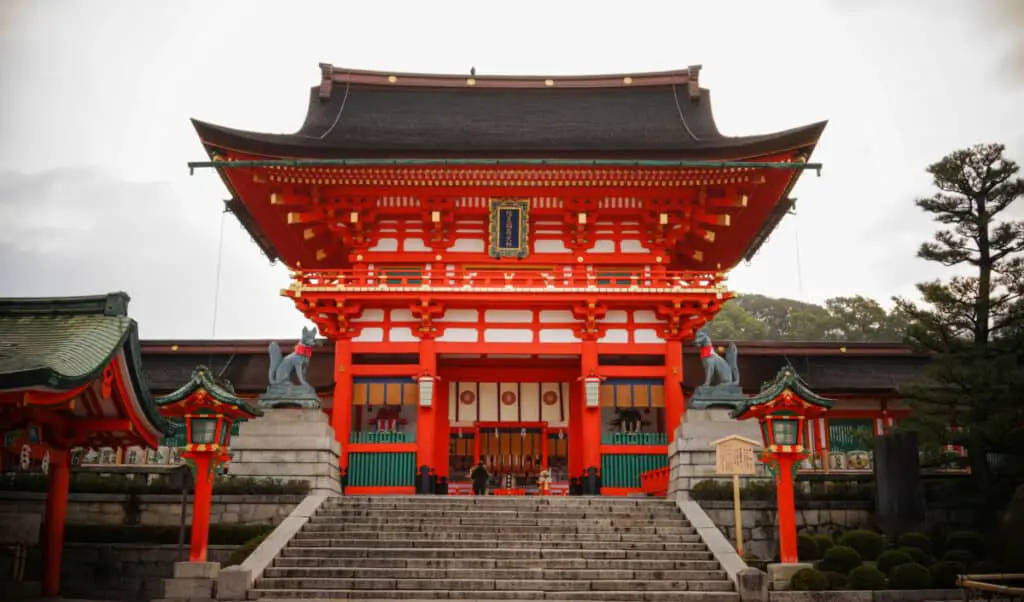
What is the Fushimi Inari Taisha Torii Gates?
Fushimi Inari is a central Shinto shrine in Kyoto’s southern district. Thousands of vermilion (red) torii gates span a network of paths behind the main structures, making it one of Kyoto’s most famous shrines.
Since foxes are regarded to be Inari’s messengers, several fox sculptures can be seen around the shrine grounds.
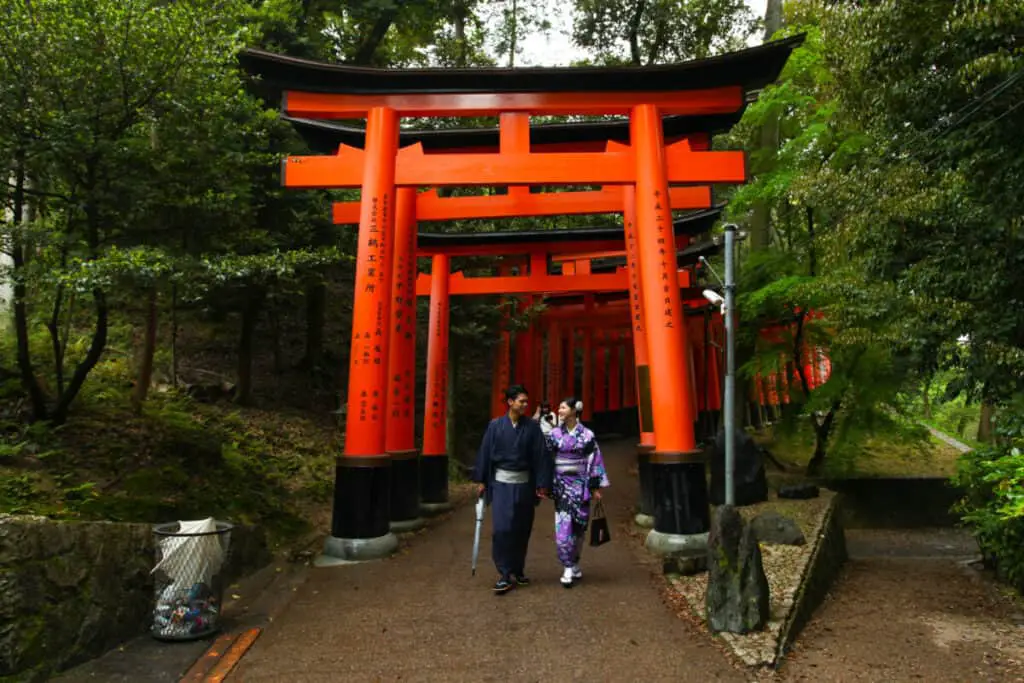
Why You Should Visit the Fushimi Inari Taisha Torii Gates
Most international visitors come to Fushimi Inari Shrine to hike the mountain paths, although the shrine structures are magnificent to view and explore.
The Romon Gate, gifted in 1589 by the famed leader Toyotomi Hideyoshi, sits at the shrine’s entrance. The shrine’s main hall lies behind it, where visitors can pay their respects to the resident god by giving a modest offering.
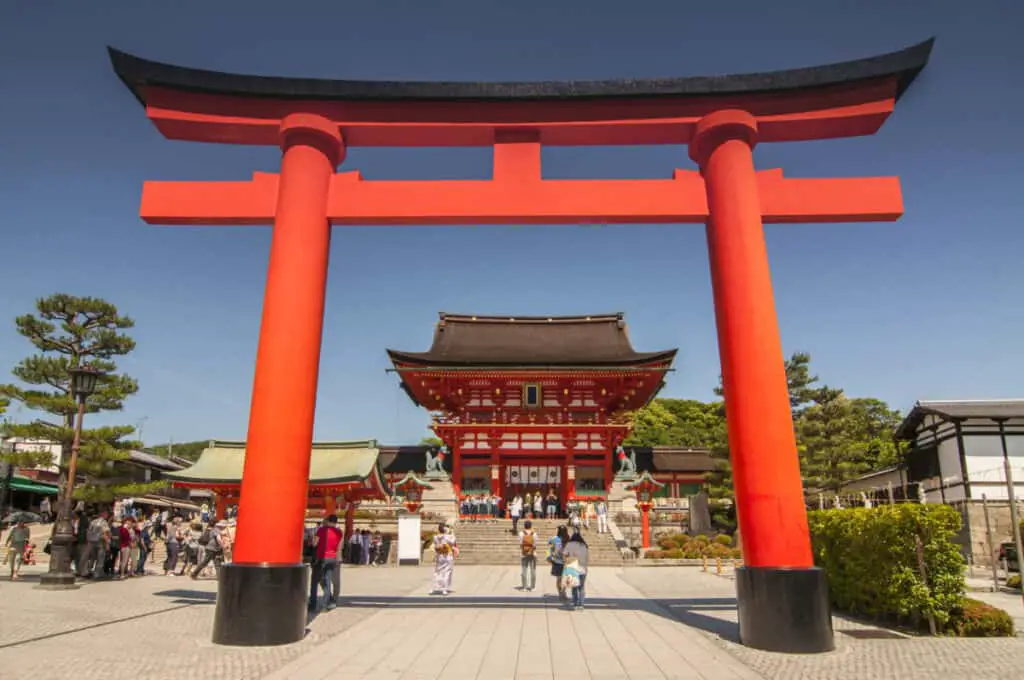
The torii gate-covered hiking route entrance is located at the extreme back of the shrine’s main grounds, and it begins with two thick, parallel rows of gates known as Senbon Torii, which translates to “thousands of torii gates.”
Individuals and businesses donated the torii gates that line the route, and the donor’s name and the year of the contribution are etched on the back of each gate.
The price of adding a small gate ranges from roughly 400,000 yen to over one million yen for large gates.
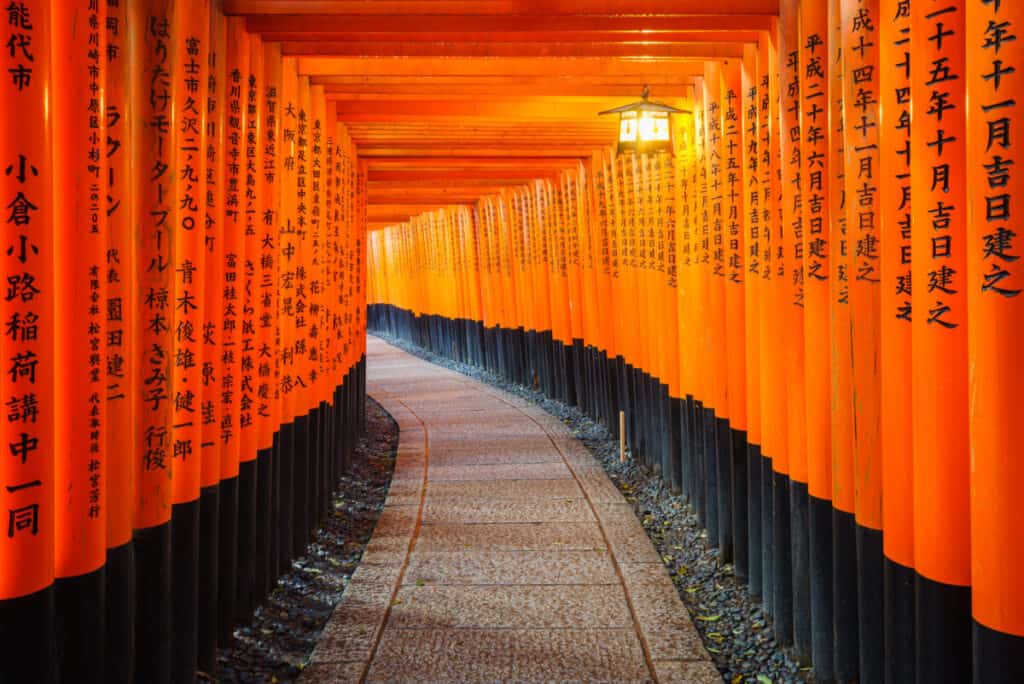
History of the Fushimi Inari Taisha Torii Gates
The Hata family built Fushimi Inari Shrine in 711, more than 80 years before Kyoto became Japan’s capital in 794. Ukanomitama-no-Mikoto is the shrine’s main deity, a mythological character who is the goddess of rice and food and is closely associated with the god Inari.
The main shrine structure, called The Go-Honden, was built in 1499. Toyotomi Hideyoshi, a warlord, erected the complex’s Romon Gate in 1589.
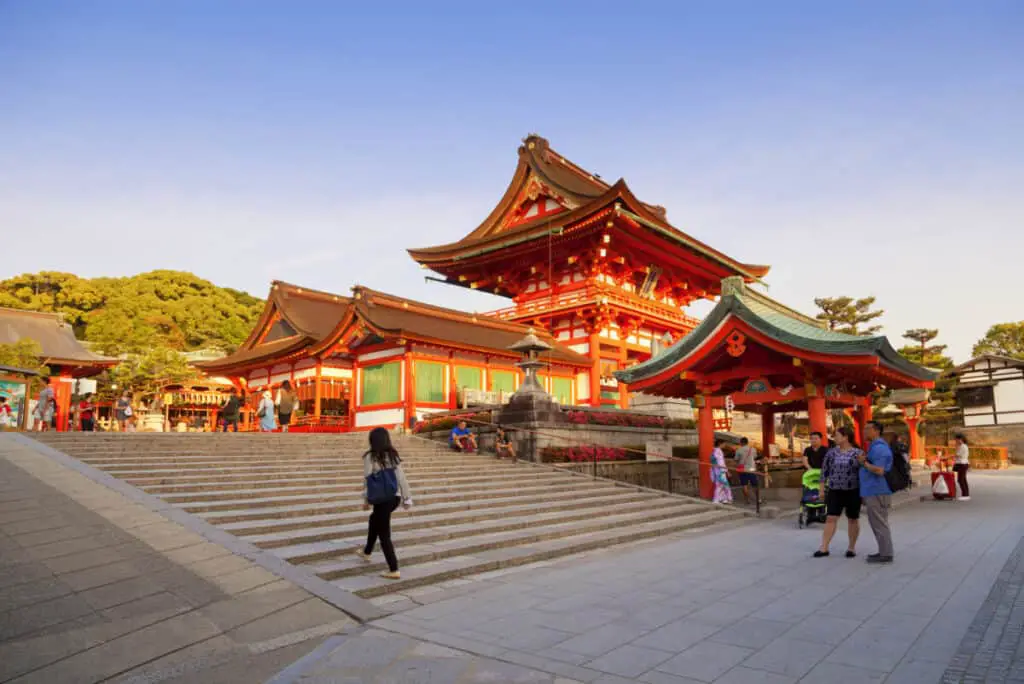
Fushimi Inari is the head shrine for the more than 30,000 smaller Inari shrines around Japan and is one of Kyoto’s most popular tourist attractions.
Fushimi Inari has also been affiliated with Shingon Buddhism since 823, a little more than a century after its foundation. At this time, the monk Kukai, the creator of Shingon Buddhism, was appointed as the abbot of Toji Temple.
Fushimi Inari was chosen as the temple’s guardian shrine, and it was moved closer to the temple. This historical connection may be seen in the Buddhist chant known as the Inari sutra.
Why are Foxes Important at the Temple?
Foxes, who are considered messengers, are frequently found at Inari temples. A key in their jaws is one of their characteristics.
Unlike other Shinto shrines, Fushimi Inari-Taisha has an open view of the main item of devotion, as is customary with Inari shrines.
Toyotomi Hideyoshi erected the shrine’s two-story entry gate, according to a painting in Kiyoshi Nozaki’s Kitsune: Japan’s Fox of Mystery, Romance, and Humor, published in 1786.
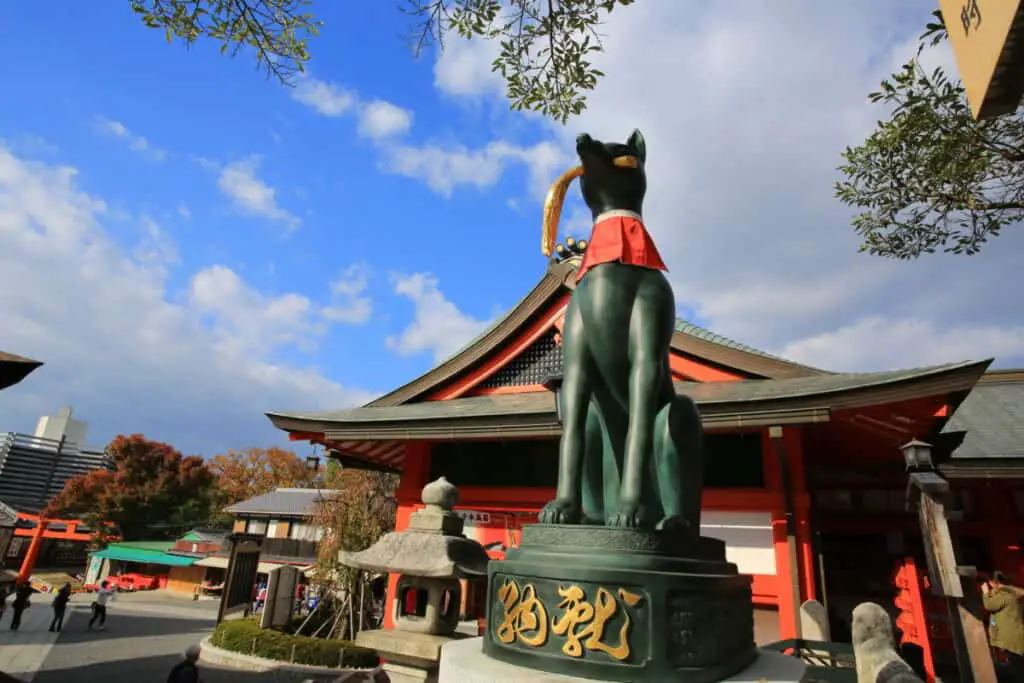
Hiking at Fushimi Inari Taisha Torii Gates
The climb to the mountain’s peak and back takes roughly 2-3 hours, although guests can travel as many miles as they desire before turning around since this trail is out and back.
Several tiny shrines with stacks of miniature torii gates given by tourists on a tighter budget can be found along the route.
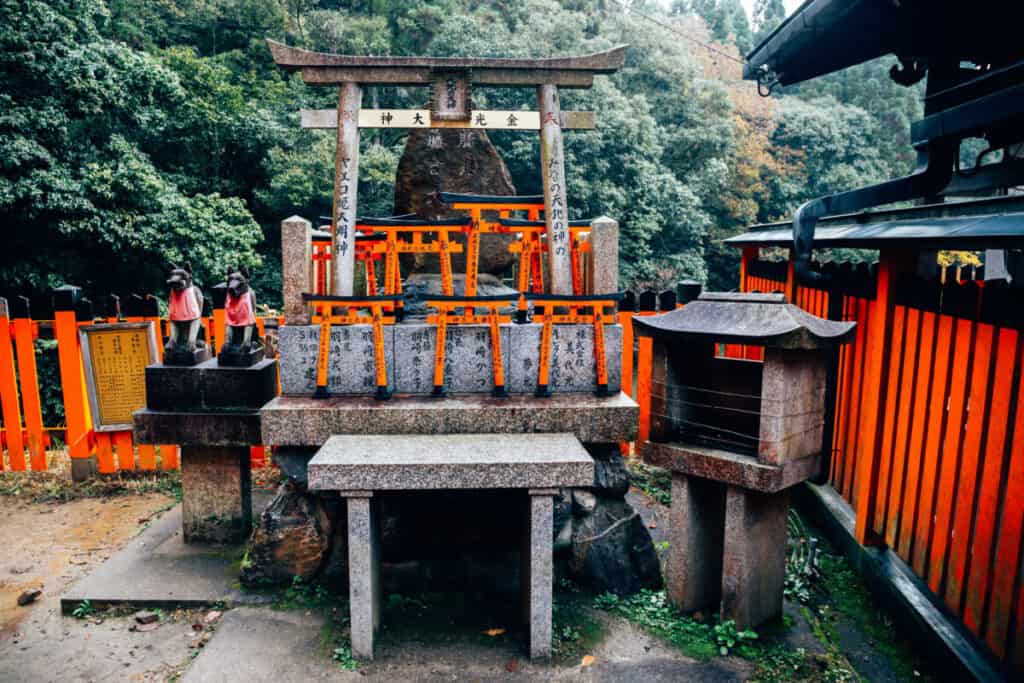
A few eateries along the road provide regionally themed cuisine like Inari Sushi and Kitsune Udon, both of which use aburaage, which is thought to be foxes’ favorite food.
After a 30–45-minute hike and a progressive decrease in the number of torii gates, visitors will reach the Yotsutsuji junction, halfway up the mountain, where the trail splits into a circular route to the top and where some great views of Kyoto may be experienced.
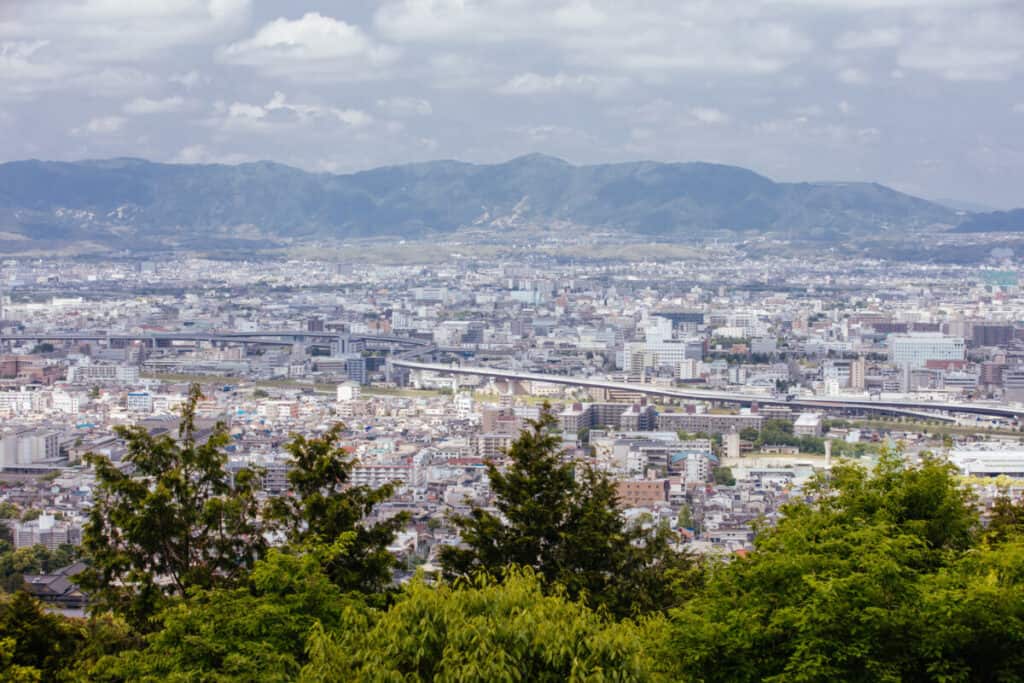
Many hikers only go as far as this point because the paths don’t provide much variety beyond this point and the gate density drops much further.
What are the Sightseeing Factors at Fushimi Inari Taisha?
The complex has many exciting statues to keep an eye out for.
However, visiting this area is an experience in itself. The roadway leading up to Fushimi Inari’s main gate is lined with kiosks serving many traditional meals, including barbecued meats, inari-zushi, and tsujiura senbei.
The Torii Tunnel
The city’s most captivating views are the unending tunnels of torii Shinto shrine gates at Fushimi-Inari Taisha in southeast Kyoto.
Passing down the walkway is considered preparing one’s mind for spiritual devotion. Do not stroll into the Torii’s center, known as “Sei-chu,” or the Gods’ Passage. Instead, take a slight detour to the side.
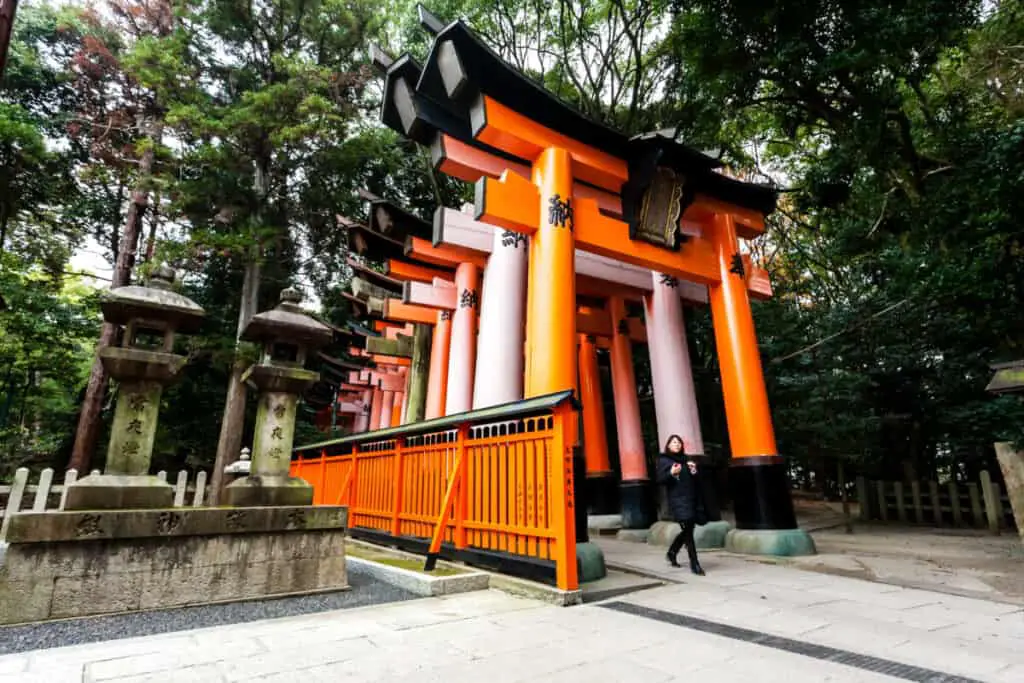
The Sacred Meaning of Torii Gates
Torii gates separate the sacred shrine grounds from the rest of the world. In other words, they act as a barrier between sacred spaces and the everyday world in which humans dwell.
You have entered the hallowed, unique zone after crossing under the torii gate.
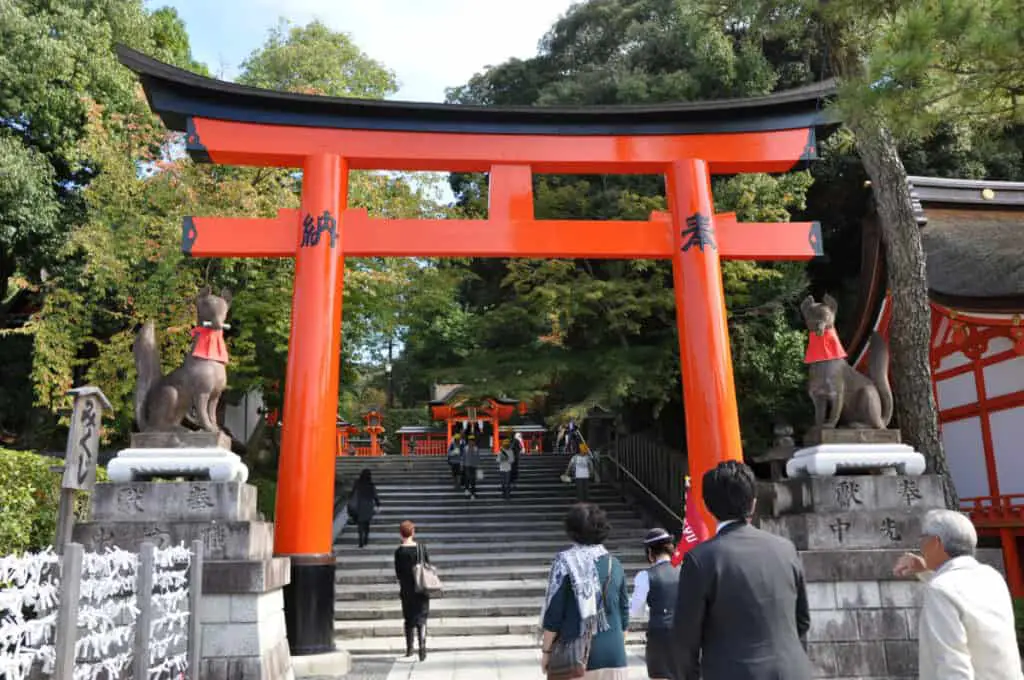
Aside from old temples, you could come across lovely torii gates that occur in unexpected places around Japan. It includes natural areas such as the foot of well-known mountains or picturesque coastal walks.
These torii gates represent a god that may be found in nature, such as sacred mountains and the sea. Animism, a Japanese indigenous belief with a lengthy history, is the name given to this concept.
When is Fushimi Inari Taisha Accessible?
The temple is located immediately outside Inari Station on the West Japan Railway Company’s (JR) Nara Line, about a five-minute journey from Kyoto Station. Fushimi-Inari Station on the Keihan Electric Railway’s Main Line is a short walk away.
Kyoto Station Official Website
The Fushimi Inari Shrine is open 24 hours a day, and both the shrine’s approach and the Honden itself are lighted at night. There is no admission charge.
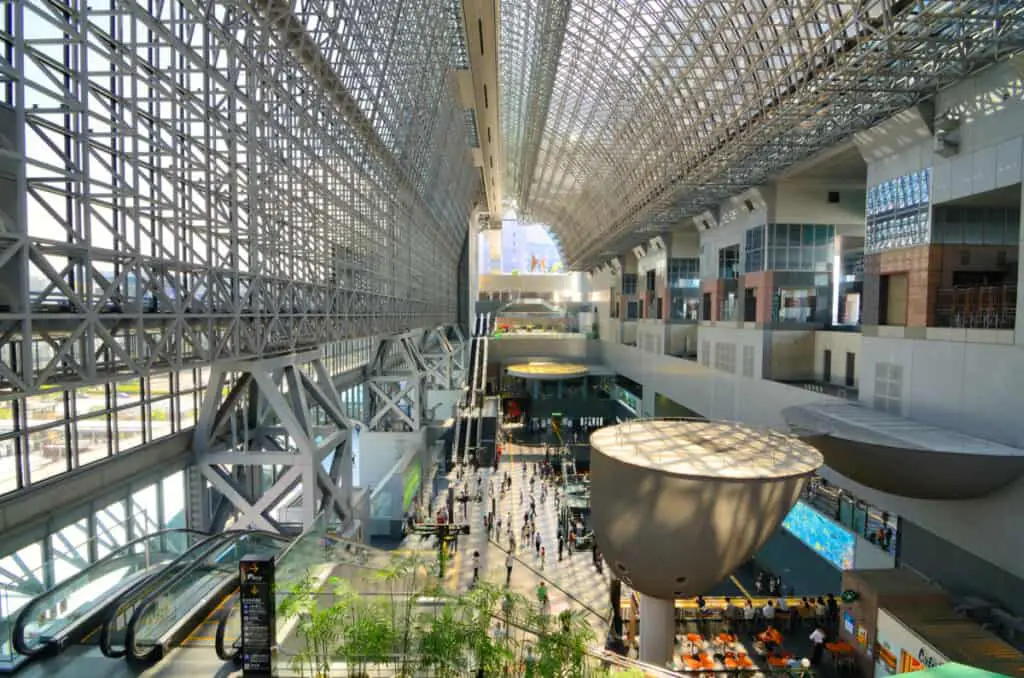
Conditions and Wheelchair Accessibility to Consider when Visiting
Visiting Fushimi Inari Shrine outside of busy hours is the best plan. The crowds might be overpowering and make moving around difficult.
The main shrine should be visited before proceeding to the rows of torii gates. The walk from the main gate to the temple is smooth and straightforward to navigate.
However, the main shrine chamber is reached through a flight of stairs. This time built with ramps, two other sets of steps can be found to the left. Unfortunately, the ramps are steep, and wheelchair users may require help.
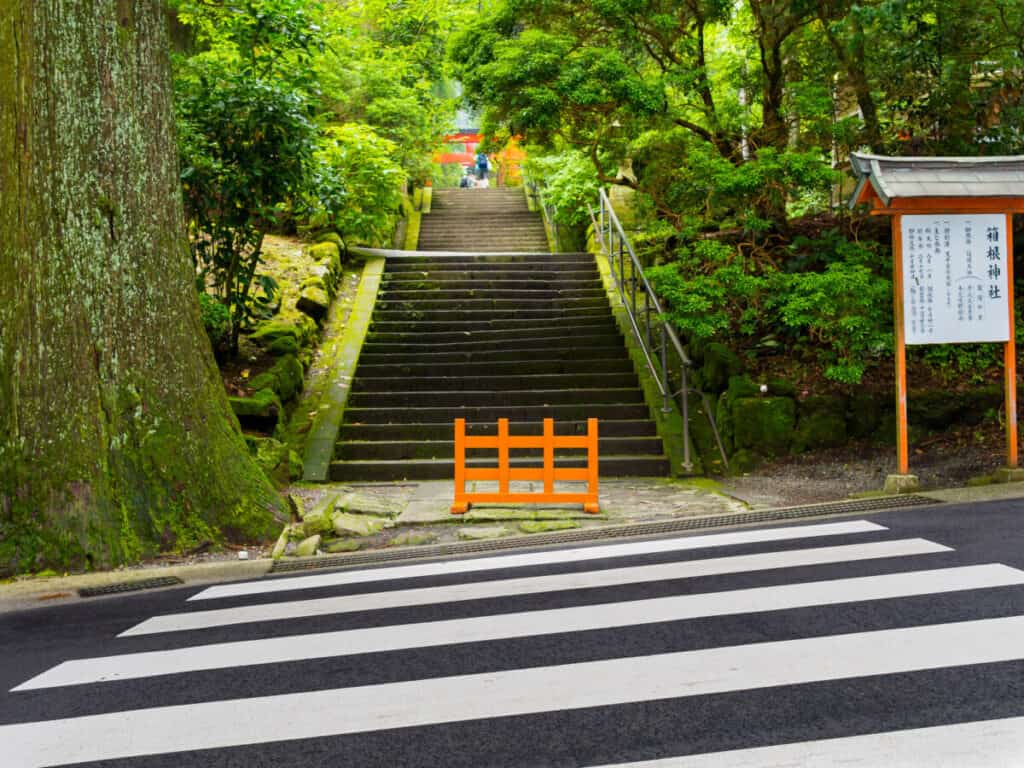
Once arriving at the main shrine hall area, a few buildings are to view. These include the shrine itself and a stage for traditional dances. There are flagstone walks in the neighborhood, but there is also gravel pathways.
Fortunately, much of the gravel has a net beneath it, so you won’t sink if you’re in a wheelchair.
An elevator behind the main shrine goes to the start of the main torii tunnel and a neatly paved walkway at the top that leads to the walks with the torii gates.
Regrettably, the routes begin to ascend the mountain and are comprised entirely of stairs. Those who are unable to climb stairs must return.
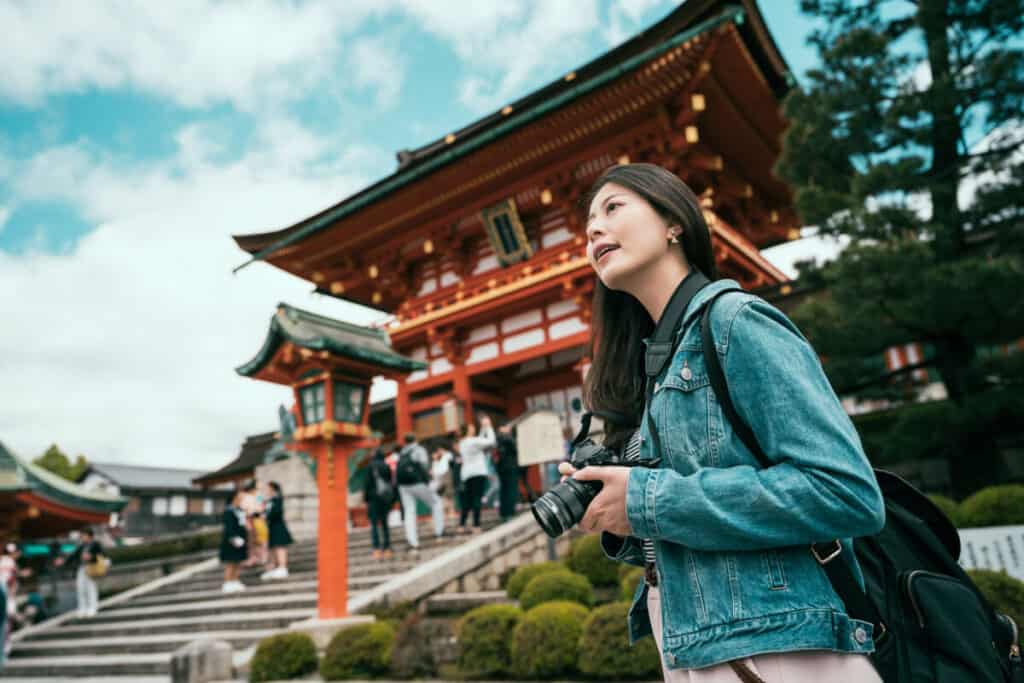
The roads are directional, so after going through the one that leads upstairs to the inner shrine, you may return down the other path, which is less busy and provides excellent photographic opportunities.
Other Tourist Attractions Nearby
Visit Mount Inari
Behind the shrine, Mount Inari is littered with smaller shrines and provides a pleasant hike, taking around 2 or 3 hours to reach the summit.
Most hikers, however, are content to travel as far as the Yotsu-suji crossroads, approximately a 40-minute trek up, for a panoramic view of Kyoto.
Taking the Train to Other Attractions
It is possible to combine a visit to Fushimi-Inari with Fushimi-Fushimi or Momoyama Castle and the Gekkeikan Sake Museum.
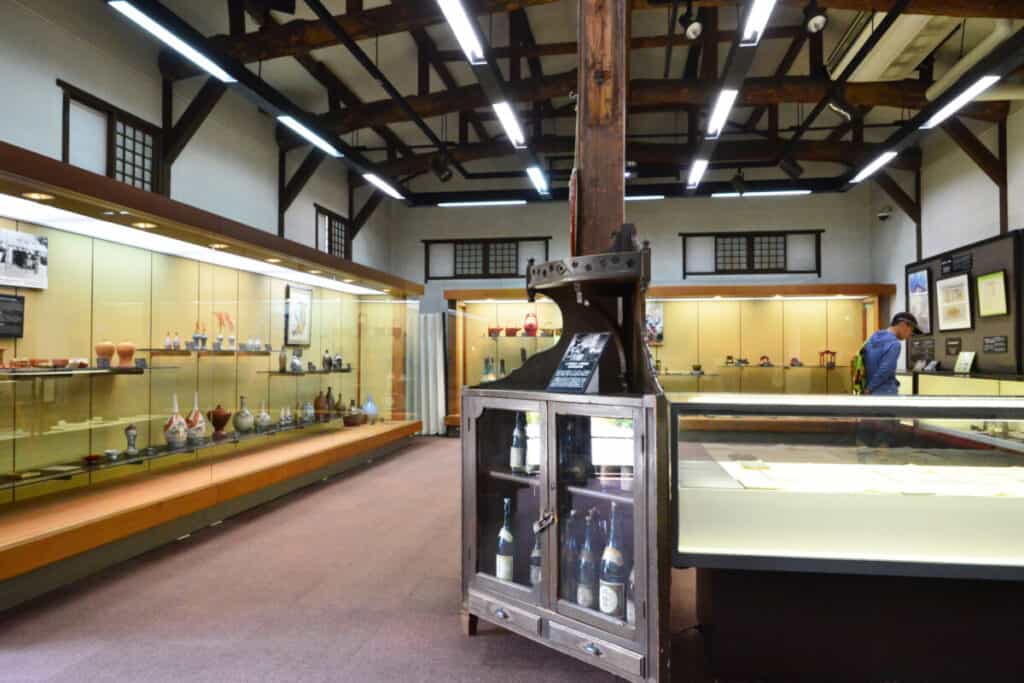
Tofukuji Temple is also two stops away from Kyoto on the Keihan Line and one-stop away from Nara on the JR Nara Line. The smaller temples of Hotoji and Sekihoji are located south of Fushimi Inari.
Sake Breweries
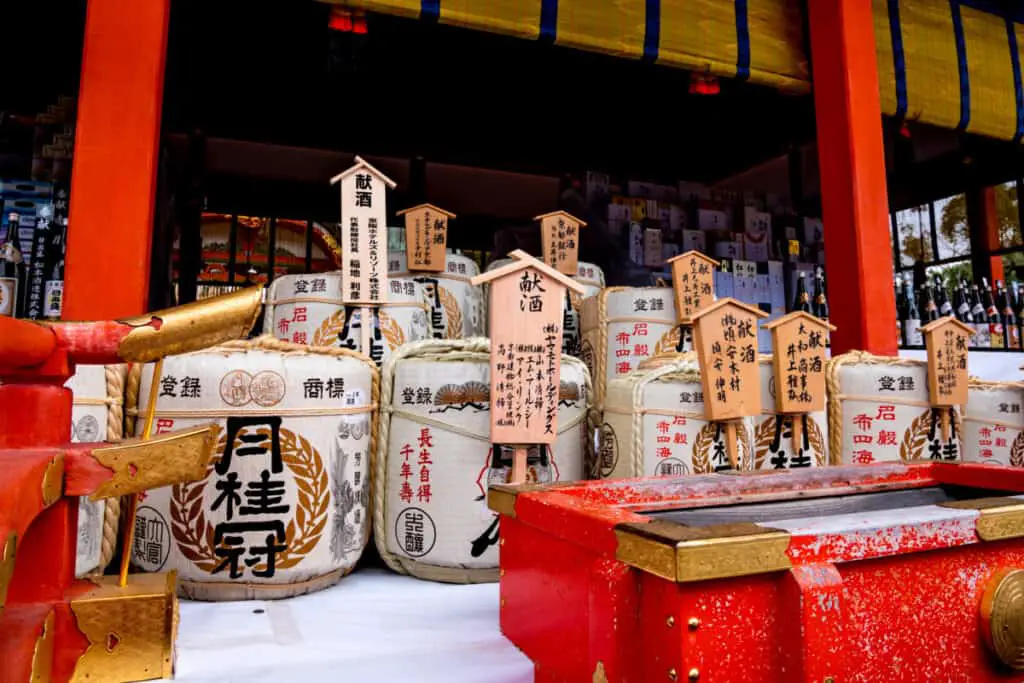
Fushimi Inari Shrine Official Website
A tour of the several sake breweries in the region can also be combined with a visit to the Fushimi Inari shrine. Two of the most popular breweries near the Fushimi Inari shrine include Matsumoto Sake Brewery and Yamamoto Honke Sake Brewery.










